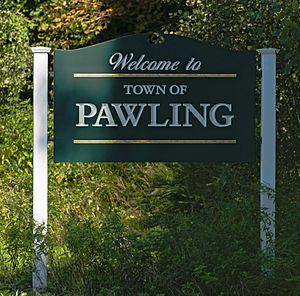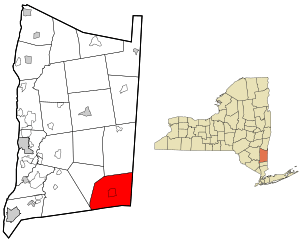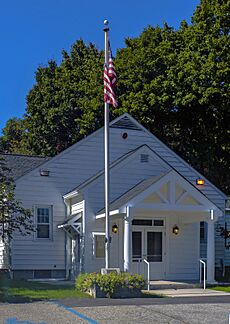Pawling (town), New York facts for kids
Quick facts for kids
Pawling
|
||
|---|---|---|

Town welcome sign along New York State Route 22
|
||
|
||
| Etymology: From Catherine Pauling, wife of Albert Pauling, and eldest daughter of colonial landowner Henry Beekman. The town received its name after a newspaper published a typo: Pawling. | ||

Location of Pawling, New York
|
||
| Country | United States | |
| State | New York | |
| Region | Hudson Valley | |
| County | Dutchess | |
| Founded | 1788 | |
| Area | ||
| • Total | 45 sq mi (120 km2) | |
| • Land | 44.2 sq mi (114 km2) | |
| • Water | 0.8 sq mi (2 km2) | |
| Elevation | 479 ft (146 m) | |
| Population
(2020)
|
||
| • Total | 8,012 | |
| • Density | 178.0/sq mi (68.7/km2) | |
| Time zone | UTC-5 (EST) | |
| • Summer (DST) | UTC-4 (EDT) | |
| ZIP Codes | ||
| Area code(s) | 845 | |
| Exchange | 855 | |
| GNIS feature ID | 0979347 | |
Pawling is a lovely town located in Dutchess County, New York, in the United States. In 2020, about 8,012 people lived here. The town got its name from Catherine Pauling, whose father, Henry Beekman, owned a very large piece of land in the area. Pawling is in the southeastern part of Dutchess County and has a small village also called Pawling inside it.
Contents
Exploring Pawling's Past
Long ago, there was a disagreement about the border between New York and Connecticut. A special strip of land, two miles wide, called "the Oblong," was part of this dispute. The first settlers in a place called Quaker Hill were Nathan Birdsall and his wife, Jane Langdon. Nathan was born around 1700 and came from Long Island. He was a surveyor, meaning he helped measure land, and he chose his home during one of his surveys.
Nathan bought his land from a large grant called the Great Nine Partners Patent. He built a log house and barn around 1720 before his family moved there. Another early settler was Benjamin Ferris, a Quaker preacher. Many people, especially Friends, started moving to the area after 1731. This was when a very old border disagreement between English and Dutch settlers was finally solved. Many Quakers came from a place called Harrisons Purchase, which is now part of Rye. Their old Quaker Meeting House is still there today and you can visit it!
During the American Revolution, George Washington, who led the colonial army, set up his headquarters in the John Kane House in Pawling for two months in 1778. The town of Pawling was officially created in 1788. Later, in 1807, a part of Pawling became the nearby town of Dover. Pawling itself was originally part of a huge land grant given to Colonel Henry Beekman in 1697, called the Beekman Patent.
Pawling's Geography and Landscape
Pawling covers a total area of about 45 square miles (116.5 square kilometers). Most of this is land, about 44.2 square miles (114.5 square kilometers), with a small part, 0.8 square miles (2.1 square kilometers), being water.
The eastern and western parts of Pawling are high and hilly. In the middle, you'll find the Great Swamp and the Harlem Valley, which is where the village of Pawling is located. The highest point in town is Observatory Hill, which is 1,332 feet (406 meters) above sea level. The lowest point is 420 feet (128 meters) in the Great Swamp, near the southern edge of the town.
Most people in Pawling live in the valley. Important roads like NY 22 and NY 55 (south of the village) run through it. The Metro-North Railroad's Harlem Line also passes through, with two train stations. The Pawling station is in the village. The Appalachian Trail station lets people get off and hike the famous Appalachian Trail into the Pawling Nature Reserve in the northern part of town.
Pawling shares its southern border with Putnam County, New York. To the east, it borders Connecticut. The town of Beekman is to the west, and Dover is to the north. Pawling also has a small border with East Fishkill in its southwestern corner.
Communities and Places in Pawling
- Baker Corner – a small community east of Hurd Corners.
- Holmes – a community in the southwestern part of the town.
- Hurd Corners – a community north of Pawling village.
- Quaker Hill – a community near the eastern town line, northeast of Pawling village.
- Pawling – the main village within the town.
- Shorehaven – a community in the western part of the town.
- West Pawling – a community on Route 55, northwest of Pawling village.
- Whaley Lake – a lake by the western town line.
- Woodinville – a community west of Pawling village.
Pawling's Population Over Time
| Historical population | |||
|---|---|---|---|
| Census | Pop. | %± | |
| 1820 | 1,804 | — | |
| 1830 | 1,705 | −5.5% | |
| 1840 | 1,571 | −7.9% | |
| 1850 | 1,720 | 9.5% | |
| 1860 | 1,743 | 1.3% | |
| 1870 | 1,760 | 1.0% | |
| 1880 | 2,006 | 14.0% | |
| 1890 | 1,949 | −2.8% | |
| 1900 | 1,921 | −1.4% | |
| 1910 | 1,927 | 0.3% | |
| 1920 | 1,955 | 1.5% | |
| 1930 | 2,391 | 22.3% | |
| 1940 | 2,752 | 15.1% | |
| 1950 | 2,891 | 5.1% | |
| 1960 | 3,938 | 36.2% | |
| 1970 | 4,764 | 21.0% | |
| 1980 | 5,795 | 21.6% | |
| 1990 | 5,947 | 2.6% | |
| 2000 | 7,521 | 26.5% | |
| 2010 | 8,463 | 12.5% | |
| 2020 | 8,012 | −5.3% | |
| U.S. Decennial Census | |||
Pawling's population has changed over the years. In 1820, there were 1,804 people, and by 2020, the population had grown to 8,012. The town is home to many families and individuals.
How Pawling is Governed
Since 1878, Pawling has had a special way of running its local government. It uses a council-manager system, where elected officials make decisions, and a professional manager helps carry them out.
Important Services in Pawling
Fire Protection
The Pawling Fire District is in charge of fire safety for the town. They work hard to make sure buildings are safe and help prevent dangerous situations. The fire department has three stations across the town because it covers a large area. They respond to fires, help with rescues, and assist during natural disasters. While the fire department handles many emergencies, ambulance services are provided by Empress Ambulance, which offers 24/7 help. If many emergencies happen at once, ambulances from nearby towns like Beekman or Dover can also assist.
Police Services
Police protection in Pawling comes from two main groups: the Dutchess County Sheriff's office and the New York State Police. Sheriff's deputies have a small office near the train station in the center of town. The MTA Police also help keep the area safe, especially around the train station since the Metro-North Railroad runs through town.
Medical Care
Pawling has several doctors' offices and clinics, like Village Medical and The Atrium. While there are no hospitals directly in Pawling, there are many medical centers and hospitals nearby. For example, MidHudson Regional Hospital and Vassar Brothers Medical Center are in Poughkeepsie. Danbury Hospital is in Danbury, Connecticut. You can also find Putnam Hospital Center in Carmel and New Milford Hospital in New Milford, Connecticut. There are also urgent care centers in nearby towns for quick medical needs.
Famous People from Pawling
- Kris Carr – an author.
- Brian Crecente – a journalist and columnist.
- Thomas E. Dewey (1902–1971) – served as Governor of New York from 1943 to 1955. He also ran for President of the United States in 1944 and 1948. He lived on a large farm in Quaker Hill.
- John B. Dutcher – a farmer, businessman, and the first President of the Village of Pawling.
- William Pearce Howland – one of the important figures in the creation of Canadian Confederation.
- John Kerr Branch (1865–1930) – a wealthy financier.
- James Earl Jones (1931–2024) – a famous actor, known for his deep voice in movies.
- Paul Tudor Jones – a commodity trader.
- Helen Lester – a children's author, creator of the character Tacky the Penguin.
- Charles H. Marsh – received a Medal of Honor for his brave actions in the Civil War.
- Marie Mattingly Meloney – a magazine editor.
- Edward R. Murrow – a famous radio and television journalist. A local park in Pawling is named after him.
- Aaron Neville – an R&B singer and musician.
- Soledad O'Brien – an American broadcast journalist.
- Norman Vincent Peale (1898–1993) – a Christian preacher and author of The Power of Positive Thinking. He also helped start Guideposts magazine. The Peale Center for Christian Living is still in Pawling.
- George T. Pierce – a lawyer and politician.
- Sally Jessy Raphael – a talk show host.
- Jean Rouverol – an author, actress, and screenwriter.
- Jean Tabaud (1914-1996) – a portrait painter and war artist.
- Lowell Thomas – helped develop the Quaker Hill community in Pawling.
- John J. Toffey – received a Medal of Honor for his brave actions in the Civil War.
- John Lorimer Worden (1818–1897) – a U.S. Navy rear admiral who commanded the ironclad ship USS Monitor during the American Civil War. He is buried in Pawling Cemetery.
- William Bernard Ziff, Jr. (1930–2006) – an American publishing executive.
Places to Visit in Pawling
- Akin Free Library – a historic stone building that houses the Gunnison Museum of Natural History and the Historical Society of Quaker Hill and Pawling.
- Daryl's House – a concert venue and restaurant owned by musician Daryl Hall.
- The Dover Oak – known as the oldest and largest oak tree found on the Appalachian Trail.
- John Kane House – a historic house that George Washington used as his headquarters during the American Revolution.
- Starkdale Farm – a farm that was used as a filming location for a TV show and a movie.
- Oblong Friends Meeting House – a historic Quaker Meeting House from the late 1700s, located in Quaker Hill.
- Peale History Center and Library – a center that celebrates the life and teachings of Dr. Norman Vincent Peale, author of "The Power of Positive Thinking."
- Trinity-Pawling School – an all-boys boarding school.
- Whaley Lake – a beautiful lake in the area.
- Pawling Free Library – located in the center of the Village, this library is a place for learning and discovery in Pawling.
See also
 In Spanish: Pawling para niños
In Spanish: Pawling para niños



